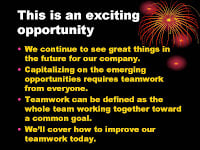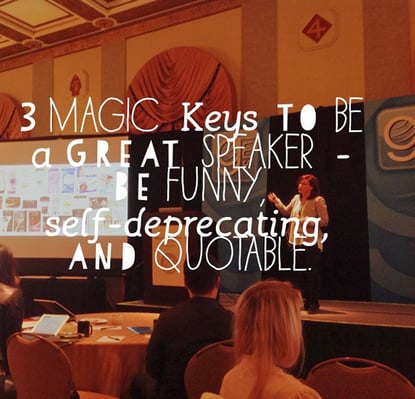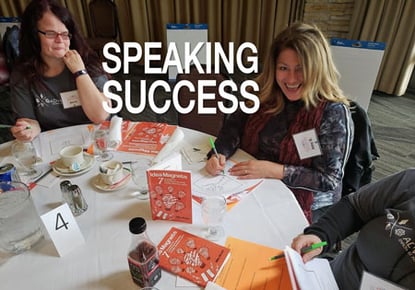 I’ve seen a variety of presenters and presentations at conferences – both good (a few) and bad (mostly). While it's great to see a presenter who has creative presentation ideas, I think there may be more to be learned from bad presenters and avoiding their presentation mistakes. Based on what most bad presenters do with Powerpoint at conferences, here are a variety of (apparently) unconventional presentation tips that can lead to dramatically more effective presentation delivery:
I’ve seen a variety of presenters and presentations at conferences – both good (a few) and bad (mostly). While it's great to see a presenter who has creative presentation ideas, I think there may be more to be learned from bad presenters and avoiding their presentation mistakes. Based on what most bad presenters do with Powerpoint at conferences, here are a variety of (apparently) unconventional presentation tips that can lead to dramatically more effective presentation delivery:
- Use fewer words on slides. Don’t show every word you plan to say in your presentation; it’s not that effective of a crutch. Fewer words (or only images) help maintain audience attention & cover your speaking flubs because the audience can’t compare what you’re saying to everything on the screen.
Ideally, you've never had to say during a Powerpoint presentation - “I know this is tough to read, but I think you’ll get the point” because if you have, that means even you realize your SLIDE SUCKS!!! You need to fix the Powerpoint slide or get rid of it and not subject the audience to your LAZINESS!!! Sorry about the outburst, but if you choose to fix your Powerpoint slide, here are three possible approaches to make it more effective:
* Prioritize the material on the Powerpoint slide - use the forced choice technique approach from a previous post to narrow the content.
* Help the audience focus– if it’s an overly detailed chart or spreadsheet on the Powerpoint slide, consider using custom animation in Powerpoint to circle the area you’re addressing or a picture insert to enlarge what you’re referencing. Other presentation design possibilities include breaking the single Powerpoint slide up into multiple slides which are legible or developing a graphic with only the point(s) you’re making.
* Do something completely different – think hard about whether there’s a story, anecdote, or image you could use to make your point in a more effective way and (I realize this is radical) completely eliminate the detailed slide.
I know this may not make sense to a bad presenter, because you think the audience REALLY needs to see everything on the Powerpoint slide to get the point. But on behalf of all audience members, we can’t SEE what’s on the slide anyway; it might as well be blank. So pick a course of action (and reach out to somebody who is a presentation design specialist to help if you’re struggling with points 2 or 3), and get back to us when you’ve fixed your Powerpoint slides!
* Practice less – and listen more. Record your presentation and listen to it. Hear what isn’t working, and fix it before you present to deliver a more effective presentation and improve your presentation skills. Reading your presentation over and over without listening to it causes you to miss obvious gaffes that listeners at a conference will readily hear.
* Cut back on multimedia & animation. Using various sounds, moving images, and videos won’t fix a presenter with poor presentation skills. It just puts more pressure on you to hit cues - the last thing you should have to be thinking about while presenting at a conference.
* Have fun – but if you’re scared or not funny, don’t throw one joke into a presentation to lighten things up.One funny comment reminds the audience how unamusing the rest of your presentation is. A better public speaking strategy? Smile throughout your presentation and quit trying to be funny if you aren’t in real life. Audiences are more forgiving of an underdog presenter who looks genuine and friendly than a public speaker who is trying to be slick but isn’t.
And if you're still struggling with whether you have too much content on your Powerpoint slides, here are two quick presentation design checks to ensure you are more effective on the detail level and clarity of your presentation slides:
Check #1– Print out your “finished” PowerPoint presentation with 16 (or at least 9) slides on the page (you can usually do this in the Printer Setup dialog – not directly in PowerPoint). At that resolution, see if you can read what’s on EVERY Powerpoint slide without squinting. If you can, your conference audience will be able to read it as well. If you can’t, neither will your audience, so go back and revisit your presentation design again.
Check #2– Cover the headline on each Powerpoint slide and ask, “Can the audience get my point from the slide’s content?” Next, cover up the content and ask, “Can the audience get my point from the headline?” Then determine, “Is the point consistent for both the headline and the content?” The right answer to all these questions is “Yes,” if you’re slide is a good one. If not, you’ve got some more work to do.
An additional presentation tip for effective public speaking (and for everyday business speak) is to avoid business cliches. A report from Dow Jones points to its review of the most overused phrases by continent. There are interesting similarities among the cliches used around the world, and it's well worth checking out the pdf. My thought? At the end of the day...go home, spend time with your family, say your prayers, and go to bed!
Simply using the principles outlined above will demonstrate to your audience that you’re thinking about them and are making strides to deliver value to them with your content. Many of the tips will help save prep time that you can use to ensure you know the content and can talk about it conversationally, even without PowerPoint. If you can do that, you’ll deliver a lot better presentation! - Mike Brown
Mike Brown is a frequent and highly rated keynote speaker on business strategy, innovation, and creativity. Learn more about his presentation topics and availability by contacting The Brainzooming Group at brainzooming@gmail.com or call us at 816-509-5320.



